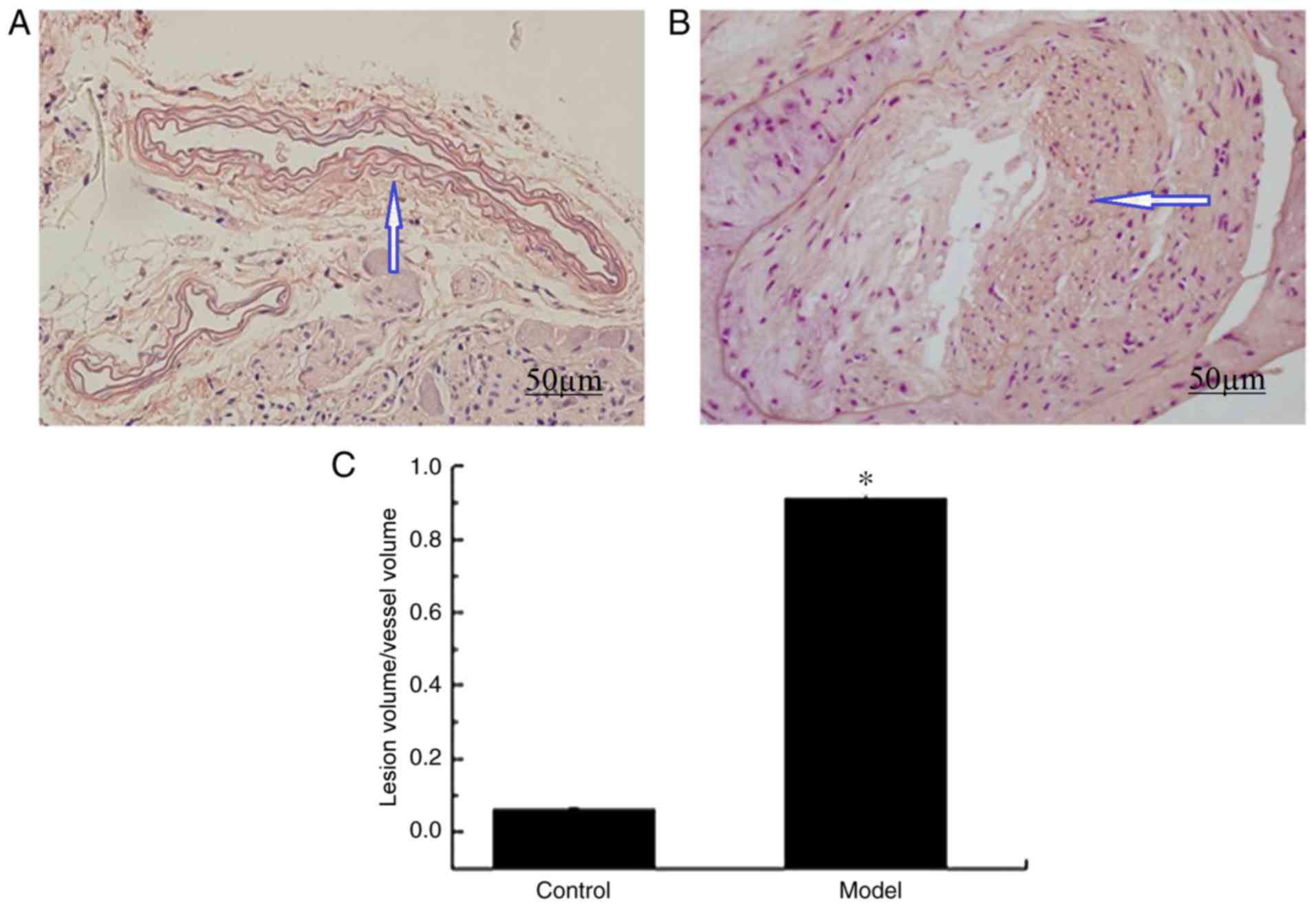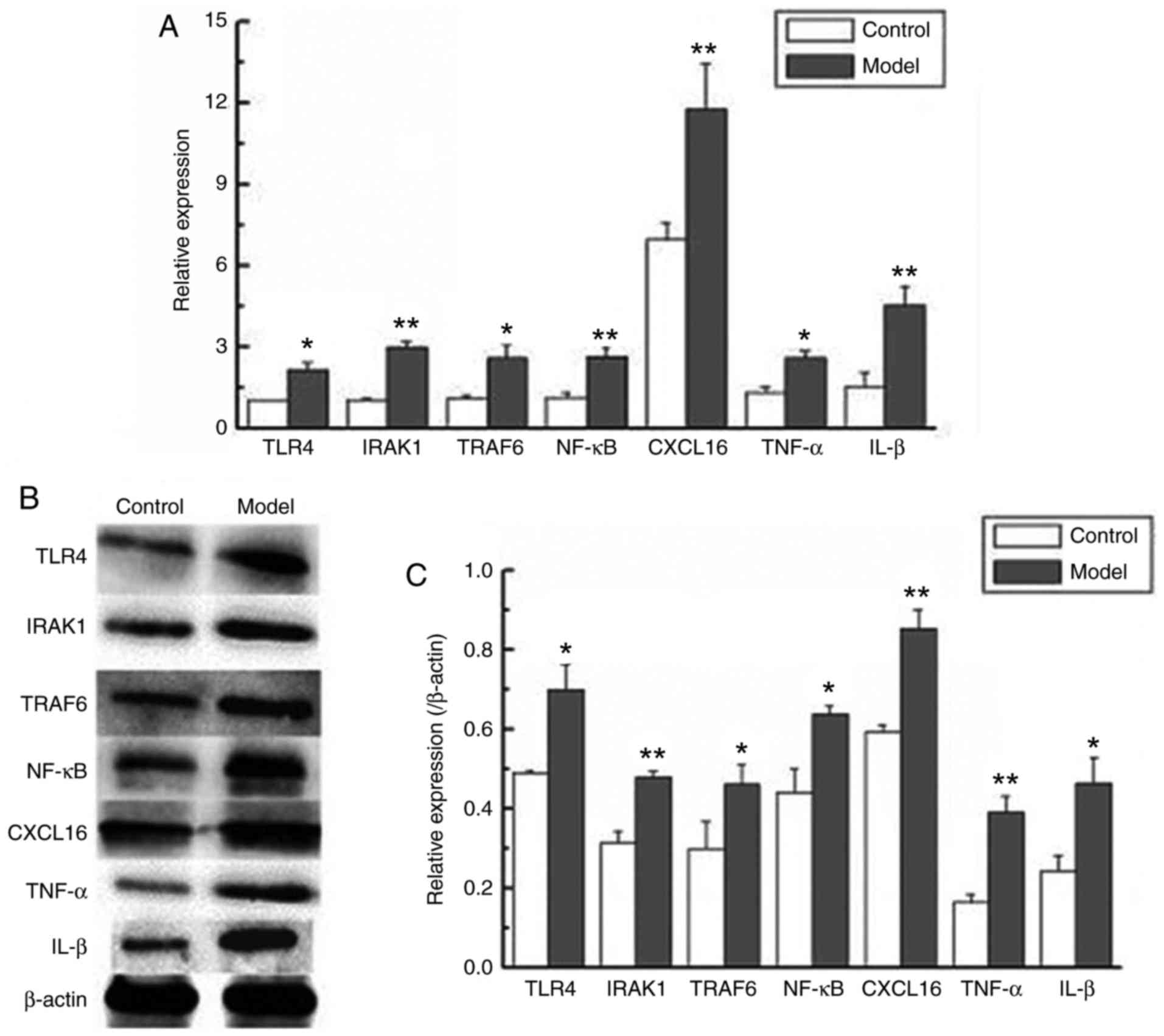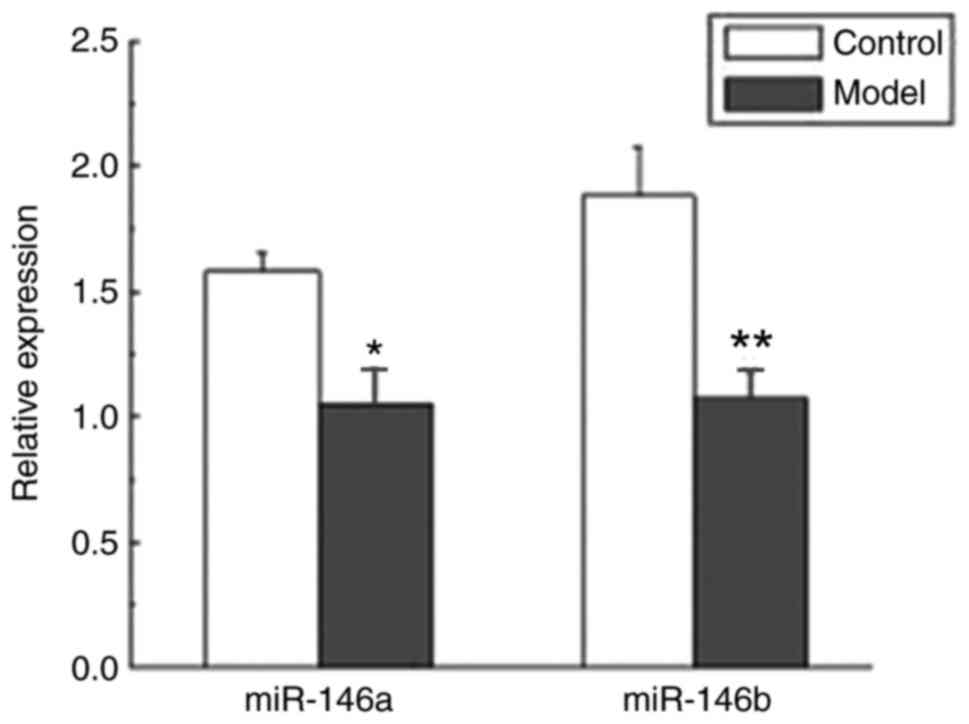|
1
|
Gimbrone MA Jr and Garcia-Cardeña G:
Vascular endothelium, hemodynamics, and the pathobiology of
atherosclerosis. Cardiovasc Pathol. 22:9–15. 2013. View Article : Google Scholar : PubMed/NCBI
|
|
2
|
Pober JS and Sessa WC: Evolving functions
of endothelial cells in inflammation. Nat Rev Immunol. 7:803–815.
2007. View
Article : Google Scholar : PubMed/NCBI
|
|
3
|
Libby P: Inflammation in atherosclerosis.
Nature. 420:868–874. 2002. View Article : Google Scholar : PubMed/NCBI
|
|
4
|
Barlic J and Murphy PM: Chemokine
regulation of atherosclerosis. J Leukoc Biol. 82:226–236. 2007.
View Article : Google Scholar : PubMed/NCBI
|
|
5
|
Borst O, Münzer P, Gatidis S, Schmidt EM,
Schönberger T, Schmid E, Towhid ST, Stellos K, Seizer P, May AE, et
al: The inflammatory chemokine CXC motif ligand 16 triggers
platelet activation and adhesion via CXC motif receptor 6-dependent
phosphatidylinositide 3-kinase/Akt signaling. Circ Res.
111:1297–1307. 2012. View Article : Google Scholar : PubMed/NCBI
|
|
6
|
Darash-Yahana M, Gillespie JW, Hewitt SM,
Chen YY, Maeda S, Stein I, Singh SP, Bedolla RB, Peled A, Troyer
DA, et al: The chemokine CXCL16 and its receptor, CXCR6, as markers
and promoters of inflammation-associated cancers. PLoS One.
4:e66952009. View Article : Google Scholar : PubMed/NCBI
|
|
7
|
Petit SJ, Wise EL, Chambers JC, Sehmi J,
Chayen NE, Kooner JS and Pease JE: The CXCL16 A181V mutation
selectively inhibits monocyte adhesion to CXCR6 but is not
associated with human coronary heart disease. Arterioscler Thromb
Vasc Biol. 31:914–920. 2011. View Article : Google Scholar : PubMed/NCBI
|
|
8
|
Minami M, Kume N, Shimaoka T, Kataoka H,
Hayashida K, Akiyama Y, Nagata I, Ando K, Nobuyoshi M, Hanyuu M, et
al: Expression of SR-PSOX, a novel cell-surface scavenger receptor
for phosphatidylserine and oxidized LDL in human atherosclerotic
lesions. Arterioscler Thromb Vasc Biol. 21:1796–1800. 2001.
View Article : Google Scholar : PubMed/NCBI
|
|
9
|
Ma A, Pan X, Xing Y, Wu M, Wang Y and Ma
C: Elevation of serum CXCL16 level correlates well with
atherosclerotic ischemic stroke. Arch Med Sci. 10:47–52. 2014.
View Article : Google Scholar : PubMed/NCBI
|
|
10
|
Ma A, Yang S, Wang Y, Wang X and Pan X:
Increase of serum CXCL16 level correlates well to microembolic
signals in acute stroke patients with carotid artery stenosis. Clin
Chim Acta. 460:67–71. 2016. View Article : Google Scholar : PubMed/NCBI
|
|
11
|
Zeng M, Yan H, Chen Y, Zhao HJ, Lv Y, Liu
C, Zhou P and Zhao B: Suppression of NF-κB reduces myocardial
no-reflow. PLoS One. 7:e473062012. View Article : Google Scholar : PubMed/NCBI
|
|
12
|
Altenburg JD and Siddiqui RA:
Docosahexaenoic acid downregulates interferon gamma-induced
expression of CXCL16 in human aortic smooth muscle cells. Biochem
Biophys Res Commun. 391:609–614. 2010. View Article : Google Scholar : PubMed/NCBI
|
|
13
|
O'Neill LA: How Toll-like receptors
signal: What we know and what we don't know. Curr Opin Immunol.
18:3–9. 2006. View Article : Google Scholar : PubMed/NCBI
|
|
14
|
Akira S and Takeda K: Toll-like receptor
signalling. Nat Rev Immunol. 4:499–511. 2004. View Article : Google Scholar : PubMed/NCBI
|
|
15
|
Lötzer K, Döpping S, Connert S, Gräbner R,
Spanbroek R, Lemser B, Beer M, Hildner M, Hehlgans T, van der Wall
M, et al: Mouse aorta smooth muscle cells differentiate into
lymphoid tissue organizer-like cells on combined tumor necrosis
factor receptor-1/lymphotoxin beta-receptor NF-kappaB signaling.
Arterioscler Thromb Vasc Biol. 30:395–402. 2010. View Article : Google Scholar : PubMed/NCBI
|
|
16
|
Ruland J: Return to homeostasis:
Downregulation of NF-κB responses. Nat Immunol. 12:709–714. 2011.
View Article : Google Scholar : PubMed/NCBI
|
|
17
|
Ma X, Buscaglia Becker LE, Barker JR and
Li Y: MicroRNAs in NF-kappaB signaling. J Mol Cell Biol. 3:159–166.
2011. View Article : Google Scholar : PubMed/NCBI
|
|
18
|
Feinberg MW and Moore KJ: MicroRNA
regulation of atherosclerosis. Circ Res. 118:703–720. 2016.
View Article : Google Scholar : PubMed/NCBI
|
|
19
|
Taganov KD, Boldin MP, Chang KJ and
Baltimore D: NF-kappaB-dependent induction of microRNA miR-146, an
inhibitor targeted to signaling proteins of innate immune
responses. Proc Natl Acad Sci USA. 103:12481–12486. 2006.
View Article : Google Scholar : PubMed/NCBI
|
|
20
|
O'Neill LA, Sheedy FJ and McCoy CE:
MicroRNAs: The fine-tuners of Toll-like receptor signalling. Nat
Rev Immunol. 11:163–175. 2011. View
Article : Google Scholar : PubMed/NCBI
|
|
21
|
Etzrodt M, Cortez-Retamozo V, Newton A,
Zhao J, Ng A, Wildgruber M, Romero P, Wurdinger T, Xavier R,
Geissmann F, et al: Regulation of monocyte functional heterogeneity
by miR-146a and Relb. Cell Rep. 1:317–324. 2012. View Article : Google Scholar : PubMed/NCBI
|
|
22
|
Jurkin J, Schichl YM, Koeffel R, Bauer T,
Richter S, Konradi S, Gesslbauer B and Strobl H: miR-146a is
differentially expressed by myeloid dendritic cell subsets and
desensitizes cells to TLR2-dependent activation. J Immunol.
184:4955–4965. 2010. View Article : Google Scholar : PubMed/NCBI
|
|
23
|
Curtale G, Mirolo M, Renzi TA, Rossato M,
Bazzoni F and Locati M: Negative regulation of Toll-like receptor 4
signaling by IL-10-dependent microRNA-146b. Proc Natl Acad Sci USA.
110:11499–11504. 2013. View Article : Google Scholar : PubMed/NCBI
|
|
24
|
Nahid MA, Pauley KM, Satoh M and Chan EK:
miR-146a is critical for endotoxin-induced tolerance: Implication
in Innate Immunity. J Biol Chem. 284:34590–34599. 2009. View Article : Google Scholar : PubMed/NCBI
|
|
25
|
Bhaumik D, Scott GK, Schokrpur S, Patil
CK, Campisi J and Benz CC: Expression of microRNA-146 suppresses
NF-kappaB activity with reduction of metastatic potential in breast
cancer cells. Oncogene. 27:5643–5647. 2008. View Article : Google Scholar : PubMed/NCBI
|
|
26
|
Boldin MP, Taganov KD, Rao DS, Yang L,
Zhao JL, Kalwani M, Garcia-Flores Y, Luong M, Devrekanli A, Xu J,
et al: miR-146a is a significant brake on autoimmunity,
myeloproliferation, and cancer in mice. J Exp Med. 208:1189–1201.
2011. View Article : Google Scholar : PubMed/NCBI
|
|
27
|
Park H, Huang X, Lu C, Cairo MS and Zhou
X: MicroRNA-146a and microRNA-146b regulate human dendritic cell
apoptosis and cytokine production by targeting TRAF6 and IRAK1
proteins. J Biol Chem. 290:2831–2841. 2015. View Article : Google Scholar : PubMed/NCBI
|
|
28
|
Pan X, Hou R, Ma A, Wang T, Wu M, Zhu X,
Yang S and Xiao X: Atorvastatin upregulates the expression of
miR-126 in Apolipoprote in E-knockout mice with carotid
atherosclerotic plaque. Cell Mol Neurobiol. 37:29–36. 2017.
View Article : Google Scholar : PubMed/NCBI
|
|
29
|
Cai X, Li X, Li L, Huang XZ, Liu YS, Chen
L, Zhang K, Wang L, Li X, Song J, et al: Adiponectin reduces
carotid atherosclerotic plaque formation in ApoE−/− mice: Roles of
oxidative and nitrosative stress and inducible nitricoxide
synthase. Mol Med Rep. 11:1715–1721. 2015. View Article : Google Scholar : PubMed/NCBI
|
|
30
|
von der Thusen JH, van Berkel TJ and
Biessen EA: Induction of rapid atherogenesis by perivascular
carotid collar placement in apolipoprotein E-deficient and
low-density lipoprotein receptor-deficient mice. Circulation.
103:1164–1170. 2001. View Article : Google Scholar : PubMed/NCBI
|
|
31
|
Xue-Mei L, Jie C, Xuan D, Xiao-Xing L,
Chun-Lin H and Yu-Jie L: Changes in CD4+CD25+
Tregs in the pathogenesis of atherosclerosis in ApoE−/− mice. Exp
Biol Med (Maywood). 242:918–925. 2017. View Article : Google Scholar : PubMed/NCBI
|
|
32
|
Hu XB, Zhang PF, Su HJ, Yi X, Chen L, Rong
YY, Zhang K, Li X, Wang L, Sun CL, et al: Intravascular ultrasound
area strain imaging used to characterize tissue components and
assess vulnerability of atherosclerotic plaques in a rabbit model.
Ultrasound Med Biol. 37:1579–1587. 2011. View Article : Google Scholar : PubMed/NCBI
|
|
33
|
Livak KJ and Schmittgen TD: Analysis of
relative gene expression data using real-time quantitative PCR and
the 2(-Delta Delta C(T)) method. Method. 25:402–408. 2001.
View Article : Google Scholar
|
|
34
|
Scalia R, Gooszen ME, Jones SP, Hoffmeyer
M, Rimmer DM III, Trocha SD, Huang PL, Smith MB, Lefer AM and Lefer
DJ: Simvastatin exerts both anti-inflammatory and cardioprotective
effects in apolipoprotein E-deficient mice. Circulation.
103:2598–2603. 2001. View Article : Google Scholar : PubMed/NCBI
|
|
35
|
Yi GW, Zeng QT, Mao XB, Cheng M, Yang XF,
Liu HT, Mao Y, Guo M, Ji QW and Zhong YC: Overexpression of CXCL16
promotes a vulnerable plaque phenotype in Apolipoprotein E-Knockout
mice. Cytokine. 53:320–326. 2011. View Article : Google Scholar : PubMed/NCBI
|
|
36
|
Yi GW and Zeng QT: Circulating CXCL16 is
related to the severity of coronary artery stenosis. Arch Med Res.
39:531–535. 2008. View Article : Google Scholar : PubMed/NCBI
|
|
37
|
Jansson AM, Aukrust P, Ueland T, Smith C,
Omland T, Hartford M and Caidahl K: Soluble CXCL16 predicts
long-term mortality in acute coronary syndromes. Circulation.
119:3181–3188. 2009. View Article : Google Scholar : PubMed/NCBI
|
|
38
|
Laugsand LE, Asvold BO, Vatten LJ, Janszky
I, Platou C, Michelsen AE, Arain F, Damås JK, Aukrust P and Ueland
T: Soluble CXCL16 and risk of myocardial infarction: The HUNT study
in Norway. Atherosclerosis. 244:188–194. 2016. View Article : Google Scholar : PubMed/NCBI
|
|
39
|
Ogawa Y, Tasaka S, Yamada W, Saito F,
Hasegawa N, Miyasho T and Ishizaka A: Role of Toll-like 4 in
hyperoxia-induced lung inflammation in mice. Inflamm Res.
56:334–338. 2007. View Article : Google Scholar : PubMed/NCBI
|
|
40
|
Mudaliar H, Pollock C, Ma J, Wu H, Chadban
S and Panchapakesan U: The role of TLR2 and 4-mediated inflammatory
pathways in endothelial cells exposed to high glucose. PLoS One.
9:e1088442014. View Article : Google Scholar : PubMed/NCBI
|
|
41
|
Campo GM, Avenoso A, Nastasi G, Micali A,
Prestipino V, Vaccaro M, D'Ascola A, Calatroni A and Campo S:
Hyaluronan reduces inflammation in experimental arthritis by
modulating TLR-2 and TLR-4 cartilage expression. Biochim Biophys
Acta. 1812:1170–1181. 2011. View Article : Google Scholar : PubMed/NCBI
|
|
42
|
Etemadi N, Chopin M, Anderton H, Tanzer
MC, Rickard JA, Abeysekera W, Hall C, Spall SK, Wang B, Xiong Y, et
al: TRAF2 regulates TNF and NF-κB signalling to suppress apoptosis
and skin inflammation independently of Sphingosine kinase 1. Elife.
4:pii: e10592. 2015. View Article : Google Scholar : PubMed/NCBI
|
|
43
|
Lehrke M, Millington SC, Lefterova M,
Cumaranatunge RG, Szapary P, Wilensky R, Rader DJ, Lazar MA and
Reilly MP: CXCL16 is a marker of inflammation, atherosclerosis, and
acute coronary syndromes in humans. J Am Coll Cardiol. 49:442–449.
2007. View Article : Google Scholar : PubMed/NCBI
|
|
44
|
Izquierdo MC, Sanz AB, Mezzano S, Blanco
J, Carrasco S, Sanchez-Niño MD, Benito-Martín A, Ruiz-Ortega M,
Egido J and Ortiz A: TWEAK (tumor necrosis factor-like weak inducer
of apoptosis) activates CXCL16 expression during renal
tubulointerstitial inflammation. Kidney Int. 81:1098–1107. 2012.
View Article : Google Scholar : PubMed/NCBI
|
|
45
|
Zhang G and Ghosh S: Toll-like
receptor-mediated NF-kappaB activation: A phylogenetically
conserved paradigm in innate immunity. J Clin Invest. 107:13–19.
2001. View Article : Google Scholar : PubMed/NCBI
|
|
46
|
Beutler B: Tlr4: Central component of the
sole mammalian LPS sensor. Curr Opin Immunol. 12:20–26. 2000.
View Article : Google Scholar : PubMed/NCBI
|
|
47
|
Johnson SM, Grosshans H, Shingara J, Byrom
M, Jarvis R, Cheng A, Labourier E, Reinert KL, Brown D and Slack
FJ: RAS is regulated by the let-7 microRNA family. Cell.
120:635–647. 2005. View Article : Google Scholar : PubMed/NCBI
|
|
48
|
Sun X, He S, Wara AKM, Icli B, Shvartz E,
Tesmenitsky Y, Belkin N, Li D, Blackwell TS, Sukhova GK, et al:
Systemic delivery of microRNA-181b inhibits nuclear factor-κB
activation, vascular inflammation, and atherosclerosis in
apolipoprotein E-deficient mice. Circ Res. 114:32–40. 2014.
View Article : Google Scholar : PubMed/NCBI
|
|
49
|
Santini P, Politi L, Vedova PD, Scandurra
R and d'Abusco Scotto A: The inflammatory circuitry of miR-149 as a
pathological mechanism in osteoarthritis. Rheumatol Int.
34:711–716. 2014. View Article : Google Scholar : PubMed/NCBI
|
|
50
|
Fish JE and Cybulsky MI: Taming
endothelial activation with a microRNA. J Clin Invest.
122:1967–1970. 2012. View Article : Google Scholar : PubMed/NCBI
|
|
51
|
Fang Y, Shi C, Manduchi E, Civelek M and
Davies PF: MicroRNA-10a regulation of pro-inflammatory phenotype in
athero-susceptible endothelium in vivo and in vitro. Proc Natl Acad
Sci USA. 107:13450–13455. 2010. View Article : Google Scholar : PubMed/NCBI
|
|
52
|
Sun X, Icli B, Wara AK, Belkin N, He S,
Kobzik L, Hunninghake GM, Vera MP; MICU Registry, ; Blackwell TS,
et al: MicroRNA-181b regulates NF-κB-mediated vascular
inflammation. J Clin Invest. 122:1973–1990. 2012.PubMed/NCBI
|
|
53
|
Li K, Ching D, Luk FS and Raffai RL:
Apolipoprotein E enhances microRNA-146a in monocytes and
macrophages to suppress nuclear factor-κB-driven inflammation and
atherosclerosis. Circ Res. 117:e1–e11. 2015. View Article : Google Scholar : PubMed/NCBI
|
|
54
|
Cheng HS, Sivachandran N, Lau A, Boudreau
E, Zhao JL, Baltimore D, Delgado-Olguin P, Cybulsky MI and Fish JE:
MicroRNA-146 represses endothelial activation by inhibiting
pro-inflammatory pathways. EMBO Mol Med. 5:1017–1034. 2013.
View Article : Google Scholar : PubMed/NCBI
|
|
55
|
Zhang L, Chopp M, Liu X, Teng H, Tang T,
Kassis H and Zhang ZG: Combination therapy with VELCADE and tissue
plasminogen activator is neuroprotective in aged rats after stroke
and targets microRNA-146a and the toll-like receptor signaling
pathway. Arterioscler Thromb Vasc Biol. 32:1856–1864. 2012.
View Article : Google Scholar : PubMed/NCBI
|
|
56
|
Gao M, Wang X, Zhang X, Ha T, Ma H, Liu L,
Kalbfleisch JH, Gao X, Kao RL, Williams DL, et al: Attenuation of
cardiac dysfunction in polymicrobial sepsis by MicroRNA-146a is
mediated via targeting of IRAK1 and TRAF6 expression. J Immunol.
195:672–682. 2015. View Article : Google Scholar : PubMed/NCBI
|

















